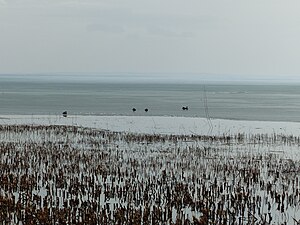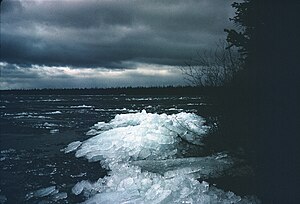86:
roads (especially salted), and snow can weaken the ice, and "tree stumps, rocks and docks absorb heat from the sun, causing ice around them to melt." Ice may melt faster along shorelines. Ice under a layer of snow will be thinner and weaker due to the snow's insulating effect; a new snowfall can also warm up and melt existing ice. However, snow or snow ice may also absorb or reflect incoming solar radiation and prevent rotting until the snow is melted. Regardless of thickness, ice will be weakened by multiple freezes and thaws or layers of snow inside the ice itself. It melts more quickly than solid ice.
31:
158:
occurs due to the hexagonal structure of the ice crystals; minerals such as salt, as well as other contaminants, can be trapped between the crystals when they initially form, and melting will begin at these boundaries due to the trapped contaminants. No matter the thickness, it can be dangerous due to its lack of horizontal structure, which means there will be no rim to grab for any person who falls through.
138:
119:
completely, then the open ocean will form new ice in the autumn. Only ice remaining at the end of summer can become second-year and subsequently multiyear ice." As rotten ice exposes more of the ocean, it also creates a feedback loop where the exposed darker ocean absorbs more heat, which melts more ice and exposes more ocean.
45:
that is melting or structurally disintegrating due to being honeycombed by liquid water, air, or contaminants trapped between the initial growth of ice crystals. It may appear transparent or splotchy grey, and it is generally found after spring or summer thaws, presenting a danger to those traveling
157:
or other body of water. It makes a clinking sound when the "candles" are broken apart and floating in the water, bumping up against each other. As ice from a larger surface melts, the formation of candle ice "progressively increases with time, temperature, and quantity of water melt runoff." This
85:
Rotting may begin at the top or bottom surface and occurs due to absorption of heat from the sun. In general, ice melting may accelerate due to various factors. Water from underneath the ice can erode the ice and cause it to be thinner without a sign on the surface. Runoff from upstream melting,
118:
and "had implications for climate science and marine vessel transport in the Arctic." Other research has found that the increased permeability of rotten ice can "contribute to ocean–atmosphere heat transfer." Future increases of rotten ice matter influence long-term ice cover: "If the ice melts
126:'s ice cover has decreased to "a rotten ice regime", with months of solid ice decreasing from 9 per year to 2-3, and with thickness decreasing from 6-10 feet to 7 inches by 2004. The decline of solid land ice to rotten ice strongly disrupts travel and subsistence hunting for the
69:
Compared to solid ice, rotten ice has "high porosity and enhanced permeability." This porosity facilitates "large convective transport of nutrients, salt and heat at the onset of fall freeze-up," which Algal bloom may also contribute. It forms on open water when
93:
studying this phenomenon hypothesizes that the polymers may provide a stabilizing effect to the ice. However, other scientists have found algae and other microorganisms produce pigments or help create a substance,
82:, but otherwise it may look grey and splotchy. Though rotten ice may appear strong, it is weak—even several feet thick may not hold a person's weight. On land, it is difficult or impossible to climb.
46:
or spending time in outdoor recreation. The increase of rotten ice vs. solid ice in the Arctic affects ocean-atmosphere heat transfer and year-to-year ice formation, as well as the lives of the
110:
north of Alaska found that most of the ice present had become rotten ice, instead of thick, solid ice that had either been newly formed or present for multiple years. This
61:
Rotten ice has a subtype called "candle ice", which has a columnar structure. Like other rotten ice, it poses a hazard to humans due to its lack of structure.
257:
Frantz, Carie M.; Light, Bonnie; Farley, Samuel M.; Carpenter, Shelly; Lieblappen, Ross; Courville, Zoe; Orellana, Mónica V.; Junge, Karen (2019-03-05).
89:
Certain types of bacteria in rotten ice pores produce polymer-like substances, which may influence the physical properties of the ice. A team from the
130:, as well as travel and habitat for sea mammals. In the future, the shedding rotted or melted ice may affect coastlines of other continents via
530:
751:
153:
Candle ice (sometimes known as needle ice) is a form of rotten ice that develops in columns perpendicular to the surface of a
702:
675:
661:
628:
481:
692:
645:
574:
204:
598:
362:
78:
during the spring or summer. If saturated with water, rotten ice may look dark or transparent, similar to new
177:
17:
756:
90:
665:
451:
555:
111:
650:. U.S. Army Materiel Command, Cold Regions Research & Engineering Laboratory. p. 27.
322:
270:
721:
8:
326:
274:
741:
505:
698:
671:
624:
340:
288:
200:
127:
79:
746:
330:
278:
392:
258:
259:"Physical and optical characteristics of heavily melted "rotten" Arctic sea ice"
335:
310:
142:
131:
115:
98:, all of which increase rotting and further the growth of the microorganisms.
421:
30:
735:
344:
292:
167:
618:
311:"Surface properties and processes of perennial Antarctic sea ice in summer"
283:
107:
590:
234:
576:
Sailing
Directions for Northern U.S.S.R.: Mys Kanin Nos to Ostron Dikson
182:
95:
55:
114:
contradicted previous impressions that Arctic ice was recovering from
660:
123:
360:
726:
71:
172:
75:
670:. Honolulu, HI: University Press of the Pacific. pp. 2–1.
51:
694:
Camping & Wilderness
Survival: The Ultimate Outdoors Book
137:
47:
154:
553:
510:
Applied
Physics Laboratory at the University of Washington
482:"NASA: May's Melting of Arctic Ice Close to Speed of July"
256:
309:
Haas, Christian; Thomas, David N.; Bareiss, Jörg (2001).
42:
619:
Bailey, William H.; Oke, T. R.; Rouse, Wayne R. (1997).
27:
Melting or otherwise disintegrating ice on open water
58:, and the microorganisms that live inside the ice.
531:"Microscopic life is melting Greenland's ice sheet"
308:
733:
199:. Jones & Bartlett Publishers. p. 112.
217:. Nickerson & Collins Co. 1898. p. 92.
554:American Geophysical Union (21 January 2010).
479:
393:"[Letter from Greenland] | Rotten Ice"
623:. Montreal: McGill-Queen's University Press.
480:Strauss, Ben; Central, Climate (2010-06-23).
722:Description and video close-up of candle ice
64:
573:Office, United States Hydrographic (1954).
727:Motion Image of Candle Ice on lake surface
361:Alberta and Northwest Territories Branch.
101:
449:
334:
282:
136:
29:
690:
643:
528:
390:
14:
734:
647:Ice Cover of an Arctic Proglacial Lake
572:
194:
662:United States Army Corps of Engineers
556:"Is ice 'rotten' in the Beaufort Sea"
422:"Ice in lakes and rivers - Ice decay"
475:
473:
471:
445:
443:
441:
416:
414:
412:
386:
384:
382:
356:
354:
304:
302:
252:
250:
248:
229:
227:
24:
241:. American Meteorological Society.
106:In 2009, researchers studying the
34:Rotten Ice Melting on Lake Balaton
25:
768:
715:
468:
438:
409:
379:
351:
299:
245:
224:
215:Ice and Refrigeration Illustrated
197:Fundamentals of Search and Rescue
122:In the years leading up to 2015,
684:
654:
637:
612:
599:American Meteorological Society
583:
566:
547:
522:
621:The surface climates of Canada
498:
391:Ehrlich, Gretel (2015-04-01).
74:and ice are mixed together or
13:
1:
752:Snow or ice weather phenomena
697:. Paul Tawrell. p. 305.
529:Pfeifer, Hazel (2021-01-20).
188:
178:Sea ice microbial communities
148:
141:Candle ice in Lake Otelnuk,
7:
644:Swinzow, George K. (1966).
161:
10:
773:
336:10.3189/172756501781831864
195:Cooper, Donald C. (2005).
65:Properties and life cycle
452:"Beware of 'rotten' ice"
450:Community (2012-04-01).
112:decline in multiyear ice
91:University of Washington
595:Glossary of Meteorology
426:Encyclopedia Britannica
239:Glossary of Meteorology
102:Role in climate science
691:Tawrell, Paul (2006).
284:10.5194/tc-13-775-2019
145:
50:, sea mammals such as
35:
506:"Extreme Summer Melt"
315:Journal of Glaciology
140:
33:
76:when polar ice melts
41:is a loose term for
486:Inside Climate News
327:2001JGlac..47..613H
275:2019TCry...13..775F
367:Lifesaving Society
146:
36:
704:978-0-9740820-2-8
677:978-0-89875-844-3
630:978-0-7735-1672-4
397:Harper's Magazine
363:"Ice Safety Tips"
132:rising sea levels
16:(Redirected from
764:
709:
708:
688:
682:
681:
658:
652:
651:
641:
635:
634:
616:
610:
609:
607:
606:
587:
581:
580:
570:
564:
563:
551:
545:
544:
542:
541:
526:
520:
519:
517:
516:
502:
496:
495:
493:
492:
477:
466:
465:
463:
462:
456:Terrace Standard
447:
436:
435:
433:
432:
418:
407:
406:
404:
403:
388:
377:
376:
374:
373:
358:
349:
348:
338:
321:(159): 613–625.
306:
297:
296:
286:
254:
243:
242:
231:
218:
210:
21:
772:
771:
767:
766:
765:
763:
762:
761:
757:Weather hazards
732:
731:
718:
713:
712:
705:
689:
685:
678:
667:Ice Engineering
659:
655:
642:
638:
631:
617:
613:
604:
602:
589:
588:
584:
571:
567:
552:
548:
539:
537:
527:
523:
514:
512:
504:
503:
499:
490:
488:
478:
469:
460:
458:
448:
439:
430:
428:
420:
419:
410:
401:
399:
389:
380:
371:
369:
359:
352:
307:
300:
255:
246:
233:
232:
225:
213:
207:
191:
164:
151:
104:
67:
28:
23:
22:
15:
12:
11:
5:
770:
760:
759:
754:
749:
744:
730:
729:
724:
717:
716:External links
714:
711:
710:
703:
683:
676:
653:
636:
629:
611:
582:
565:
546:
521:
497:
467:
437:
408:
378:
350:
298:
269:(3): 775–793.
263:The Cryosphere
244:
222:
221:
220:
219:
211:
205:
190:
187:
186:
185:
180:
175:
170:
163:
160:
150:
147:
143:Quebec, Canada
116:climate change
103:
100:
66:
63:
26:
9:
6:
4:
3:
2:
769:
758:
755:
753:
750:
748:
745:
743:
740:
739:
737:
728:
725:
723:
720:
719:
706:
700:
696:
695:
687:
679:
673:
669:
668:
663:
657:
649:
648:
640:
632:
626:
622:
615:
600:
596:
592:
586:
579:. p. 78.
578:
577:
569:
561:
560:Science Daily
557:
550:
536:
532:
525:
511:
507:
501:
487:
483:
476:
474:
472:
457:
453:
446:
444:
442:
427:
423:
417:
415:
413:
398:
394:
387:
385:
383:
368:
364:
357:
355:
346:
342:
337:
332:
328:
324:
320:
316:
312:
305:
303:
294:
290:
285:
280:
276:
272:
268:
264:
260:
253:
251:
249:
240:
236:
230:
228:
223:
216:
212:
208:
206:9780763748074
202:
198:
193:
192:
184:
181:
179:
176:
174:
171:
169:
168:Polar ice cap
166:
165:
159:
156:
144:
139:
135:
133:
129:
125:
120:
117:
113:
109:
99:
97:
92:
87:
83:
81:
77:
73:
62:
59:
57:
53:
49:
44:
40:
32:
19:
693:
686:
666:
656:
646:
639:
620:
614:
603:. Retrieved
601:. 2012-02-20
594:
591:"Candle ice"
585:
575:
568:
559:
549:
538:. Retrieved
534:
524:
513:. Retrieved
509:
500:
489:. Retrieved
485:
459:. Retrieved
455:
429:. Retrieved
425:
400:. Retrieved
396:
370:. Retrieved
366:
318:
314:
266:
262:
238:
235:"rotten ice"
214:
196:
152:
121:
108:Beaufort Sea
105:
88:
84:
68:
60:
38:
37:
128:local Inuit
736:Categories
605:2021-03-17
540:2021-03-18
515:2021-03-18
491:2021-03-18
461:2021-03-18
431:2021-03-18
402:2021-03-18
372:2021-03-18
189:References
183:Frazil ice
149:Candle ice
96:cryoconite
56:polar bear
39:Rotten ice
18:Candle ice
742:Water ice
345:0022-1430
293:1994-0416
124:Greenland
80:black ice
664:(2002).
162:See also
72:snowpack
747:Sea ice
323:Bibcode
271:Bibcode
173:Sea ice
701:
674:
627:
343:
291:
203:
52:walrus
48:Inuit
699:ISBN
672:ISBN
625:ISBN
341:ISSN
289:ISSN
201:ISBN
155:lake
54:and
535:CNN
331:doi
279:doi
43:ice
738::
597:.
593:.
558:.
533:.
508:.
484:.
470:^
454:.
440:^
424:.
411:^
395:.
381:^
365:.
353:^
339:.
329:.
319:47
317:.
313:.
301:^
287:.
277:.
267:13
265:.
261:.
247:^
237:.
226:^
707:.
680:.
633:.
608:.
562:.
543:.
518:.
494:.
464:.
434:.
405:.
375:.
347:.
333::
325::
295:.
281::
273::
209:.
134:.
20:)
Text is available under the Creative Commons Attribution-ShareAlike License. Additional terms may apply.

